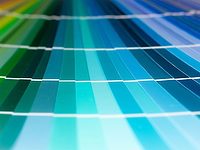Forecasting Industrial Color Trends
An Interview with Sherwin-Williams DesignHouse

 Color trends are a popular topic, often featured in the architectural coatings industry. However, color in the industrial coatings space is a market driver as well. Industrial coatings require technologies for a variety of substrates across various industries. Where and how does color play a role in the present and future of industrial coatings?
Color trends are a popular topic, often featured in the architectural coatings industry. However, color in the industrial coatings space is a market driver as well. Industrial coatings require technologies for a variety of substrates across various industries. Where and how does color play a role in the present and future of industrial coatings?
In pursuit of this answer and in order to gain more insight on these color trends, PCI Magazine Chief Editor, Kristin Johansson, interviewed Kiki Redhead, Global CMF and Trend Manager for Sherwin-Williams General Industrial’s DesignHouse.
PCI: Can you tell us a bit about the DesignHouse team – what is unique about it?
Redhead: The DesignHouse team consists of three women, each with deep expertise in industrial color and design. We work with the General Industrial and Coil Coatings divisions of Sherwin-Williams, which are headquartered in Minneapolis and cater to OEMs and manufacturers across a wide range of industrial markets. We are the only all-woman team in the two divisions, which makes us pretty unique both within the company and in the coatings industry.
 The DesignHouse all-women team: Kiki RedHead, Global CMF and Trend Manager; Ashley Cribb, Vice President, Global Sales & Marketing; Leah Novotny, Industrial Color Designer; and Brynn Wildenauer, Architectural Color Designer.
The DesignHouse all-women team: Kiki RedHead, Global CMF and Trend Manager; Ashley Cribb, Vice President, Global Sales & Marketing; Leah Novotny, Industrial Color Designer; and Brynn Wildenauer, Architectural Color Designer. Speed to market is incredibly important for our customers, and color development can be a lengthy process, especially when working from various locations. So instead of going back and forth via e-mail, mailing physical color samples, waiting for feedback and so on, we invite customers to Minneapolis to collaborate face-to-face.
At DesignHouse, we have the space and resources to explore ideas. There’s a lightroom to show how colors will look in different settings/lightings, as well as a trove of color samples to help pin down the right texture and finish. If needed, we can walk next door to the lab and test a new mix, or across the street to chat with R&D. Being there allows customers to ask the “what if” questions and find out what’s possible in real time. It’s a much more efficient, productive and collaborative process. We’ve helped companies cut their color development timeline in half.
PCI: Can you discuss what goes into analyzing color trends for industrial coatings?
Redhead: Color trend analysis is some of our most exciting work. It’s something that a lot of industrial coatings companies don’t offer, so we’re proud to make it a big part of our portfolio. Most people know Sherwin-Williams for our house paint. Our role at DesignHouse is to bring that color expertise to the industrial market, and we're successful in large part because of our color trend research.
Forecasting color trends is a complex and data-driven process. We publish a full color trend analysis every two years, with forecasts projecting three to five years into the future. We are constantly keeping tabs on industry trends, ensuring our projections are valid.
We connect the dots between our customers’ industries and a whirlwind of outside influences like shifts in consumer demand, emerging market challenges, political climates, and other global events that might trigger unforeseen changes. We look back at the past and gather insights from varying markets to determine how a color space is projected to evolve. Color is closely tied to emotion, so the general sentiment of the public must be factored in as well.
PCI: Have you been able to analyze your analyses? In other words, look back at your predictions to see what was right?
Redhead: Yes! In fact, our latest trend analysis, V, which was released in 2023 in celebration of the five-year anniversary of DesignHouse, does just this. We often check ourselves internally to see where we were on track, or what may have influenced any unforeseen shifts. We realized that this could be helpful to the market as well, so we included a deep dive retrospective in V that analyzes predictions from our previous four trend reports, then forecasts how color will continue to emerge and evolve over the next five years.
PCI: What kinds of unforeseen events can influence color forecasts?
Redhead: There are many things, big and small, that can impact the direction of color trends. Some are industry-specific and only affect a certain market, while others impact the entire global manufacturing landscape.
Some industries lean towards a certain color group for the emotion it evokes, but if the general feeling about that color shifts, or its meaning gets marred by association, that industry may start trying out different shades. On a global scale, the pandemic and subsequent period of forced isolation caused unforeseen shifts across markets and industries. The longing for togetherness led to an increased use of textured materials, as their tactile nature offered a new form of feeling connected to the world around us, driving the use of wrinkles, crinkles, and blended consistencies in the industrial market.
PCI: Do you ever collaborate with customers on color development projects? If so, can you give an example?
Redhead: DesignHouse is built for collaboration. We have helped many companies large and small determine the best palettes for their next projects. As part of the General Industrial team, we work in a variety of markets, from appliances to building products, and have customers on site at least once a week.
One customer in agricultural manufacturing came to us seeking a new brand color that could unify their portfolio, consolidate production needs to reduce costs, and establish a definitive brand look for the company.
We began with the development of an initial panel review, with selections based on several strategic factors, including agricultural industry and general heavy equipment color trends, emerging and shifting hues in the marketplace, and forecast analysis. From there, we translated the swatches into formulations we could test on metal panels offsite to account for reactions to natural light and juxtapositions with existing brand colors.
A key team of their design, marketing, and production stakeholders came to DesignHouse for a workshop to review colors and results, honing in on a specific shade that they took for testing in their facility. Following their evaluation, we arrived at a final color: a clean, chromatic hue that establishes a signature color and brand voice for the company, strengthening their marketing reach and industry impressions, and enhancing consolidation and cost-savings for their production teams.
PCI: Can you discuss the ideation of aesthetics, performance and sustainability in industrial coatings?
Redhead: Industrial customers typically have much longer lead times for production, which means the products they’re manufacturing today need to be on trend for years to come. Color and finish are the first thing people notice, so these decisions are critical to success in the marketplace. But our customers need more than just a beautiful finish. They need a coating that lasts through years of exposure to harsh environments and the toughest day-to-day use, with color that remains consistent across product lines and substrates. And they are increasingly attuned to the impact their actions have on the environment, so more than ever, they’re paying attention to the impact of the products they use.
Every color we develop has performance and sustainability factored in. When collaborating with customers, we gather as much information as possible about the end use of the product and tailor our solutions to fit. Sherwin-Williams has a wide array of high-performing liquid, powder and e-coat technologies for the industrial market, so we have a lot to work with.
If a customer is focused on sustainability, we have a line of powder coatings with resins made from recycled plastic. It’s called Powdura® ECO and it offers reduced CO2 emissions without compromising any aspects of its industrial performance. We also have multiple solutions with low-VOC options, as well as fast-drying and low-cure platforms that help reduce energy usage.
Beyond aesthetics and performance, industrial customers also need efficiency. Coatings must be available as needed on a consistent basis, with an efficient application process that streamlines production and optimizes profitability. We collaborate with our customers at DesignHouse, then engage our facilities teams to find the most efficient solutions that fit the customers’ unique situation. Then, our technical service team helps those customers implement the new solutions successfully in their application facilities.
PCI: What color trends are you seeing now in industrial coatings?
Redhead: Overall, we’re seeing a general push toward authenticity. Different industries have long favored specific colors. Blue, for example, is popular among healthcare brands, while greens tend to be used more by the heavy equipment and agriculture markets. The need for authenticity is driving these industries to lean into those market colors.
We’re also seeing a shift toward coatings that mimic the aesthetic of other materials. We recently had a customer ask us to create the look of an ultra-fine, satin finish that would give the soft, cool appearance of anodized metal. We are continuing to evolve as technology advances and we’re better able to capture the aesthetics of other materials. Check out our latest trend release, V: An Analysis Report, for a deeper dive into these.
*Images courtesy of Sherwin-Williams.
Looking for a reprint of this article?
From high-res PDFs to custom plaques, order your copy today!









